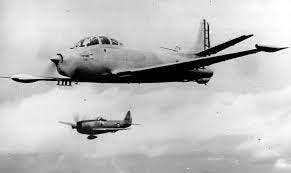We will pit French and British aircraft against each other to find out who was the European king of post-war aviation (sorry Sweden). Let us begin with a pleasingly grotesque British aircraft and its equally impressive French counterpart. Over to Jim Smith.
Maritime Birds with More Famous Relatives
These two aircraft were designed to meet maritime patrol and strike requirements, and were broadly contemporaneous; the Blackburn YB-1 made its first flight in July 1950, about a year earlier than the Breguet 960 Vultur.
Both aircraft sought to deliver mission flexibility through novel powerplant arrangements. In the case of the YB 1, the design was competing with the Fairey Gannet for orders from the Royal Navy, and like the Gannet, was powered by the 2950 equivalent shaft horse power (eshp) Armstrong-Siddeley Double Mamba turbo-prop powerplant. This consisted of two Mamba turbo-prop engines geared together in such a way that either engine could be used for cruising flight, while the other was stopped to improve cruising endurance with no adverse effects on handling qualities. Both engines were used for flight at higher speeds and for take-off and landing.
Like the Gannet, the aircraft had a crew of three, a large weapons bay for stores, and a retractable radome in the lower rear fuselage. While the concept, overall layout and powerplant essentially follow the same pattern as the Fairey Gannet, and the aircraft offered similar performance, the overall appearance is somehow less attractive. While such aspects are somewhat subjective, the large tailplane dihedral; the unusual wing planform, with a straight centre section, and slightly swept outer wings; and the unattractive nose profile all detracted from its appearance compared to the chubby, but competent-looking Gannet. For whatever reason, the YB 1 lost out to the Gannet and failed to receive a production order.
The only way to make a book as uncompromised as The Hush-Kit Book of Warplanes is crowdfunding, put the power in your hands, we are currently Vol 2 happen here. It is currently at 58% funded. If you pre-order your copy now, you get a great early price and your name printed in EVERY book. Once the book reaches 100% funded work can begin on it.
The Breguet 960 Vultur was intended to fulfil maritime strike and patrol roles, and like the YB 1 used its power plant design to deliver mission flexibility, offering both relatively high dash speed and long endurance. This was achieved using a mixed powerplant concept, with a single Armstrong-Siddeley Mamba turbo-prop cruise powerplant supplemented by a 5000 lb thrust Hispano Nene turbojet used for take-off and to increase dash speed when necessary.
A variety of armament options were available, although no internal weapons bay was fitted. Instead, a 2200 lb bomb could be carried on the fuselage centre-line, supplemented by underwing rocket projectiles. Alternatively, an anti-submarine radar could be carried under the fuselage, in which case the wing carriage points would be available for anti-submarine stores.
The mixed powerplant offered an attractive dash speed of up to 555 mph and an endurance of up to 4 hours on the Mamba alone, both figures well in advance of those offered by the YB-1 or the Fairey Gannet. However, the aircraft was complex and heavy, and could not readily fulfil both anti-submarine and strike roles.
Consequently, the Breguet 960 Vultur did not receive any production orders. However, the basic configuration was used as the starting point for the design of the Breguet 1050 Alizé, which first flew on October 6, 1956, and was not withdrawn from service until the year 2000. Compared to the Vultur, the Alizé was lighter and simpler, featuring a retractable ASW radar in the rear fuselage, a weapons bay, and a three-person crew, largely enabled by the abandonment of the mixed power plant and the adoption of the 2,000 shp Rolls-Royce Dart turboprop engine.
The Blackburn YB 1 was a more effective strike and anti-submarine package than the Breguet Vultur, although the latter was arguably more innovative, and was certainly a better looker. Neither aircraft was successful in winning a production order; the YB 1 lost out to the Fairey Gannet, and the Breguet Vultur was radically re-worked in the form of the Breguet Alizé, which enjoyed a very long service life.
The Breguet 960 Vultur receives my vote on the grounds of its looks and its successful development into the Breguet Alizé, despite the probable greater mission flexibility and effectiveness of the Blackburn YB-1. Perhaps, in the end, the YB 1 was a child ‘that only a mother could love’, to quote the movie Dumbo.









Ahh the YB1 - Blackburns’ ‘ideas man’ was given a blurry photo of a Gannet, locked in the downstairs loo with a biro and told to ‘knock one out’ before lunch. The result, scratched out on several sheets of Izal, looking for all the world like one of those ‘approximate’ Chinese toy aeroplanes you used to get in seaside toyshops in the 70s. Bring back those hazy lazy crazy days when aeroplanes were designed by a comittee largely made up of the tea lady, Nigel from accounts and the warehouse cat. Standard. (unless of course you were pointed at one and told to get in - aren’t all FAA kites supposed to be lethal to their drivers?)